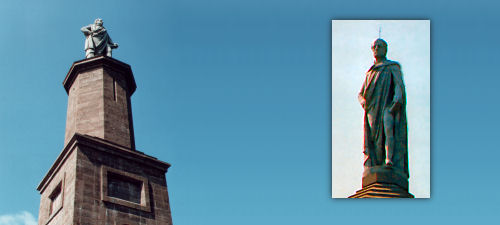Golspie (Scottish Gaelic:
Goillspidh)
is a village in Sutherland, Highland, Scotland, which lies on
the North Sea coast in the shadow of Ben Bhraggie.
Originally a small fishing hamlet Golspie
was, like many villages on the east Sutherland coast, expanded
in the early nineteenth century to house some of those evicted
from the inland straths and glens during the clearances. Fishing
was the main industry, but the opening of the railway in 1868
brought the first tourists to the area.
Golspie today is an attractive little
seaside resort with much for the visitor to see and do. The
village boasts a long sandy beach and there a number of scenic
walks around the area, including one at the Big Burn with its
spectacular waterfalls.
There are a number of historic buildings
too, including St Andrews church dating from the sixteenth
century and, most famously, Dunrobin Castle. This is one of the
grandest houses in the north of Scotland and is situated just
north of the village. It is believed to be one of the oldest
continuously inhabited homes in Britain, the oldest part of the
castle dating from the early fourteenth century. As well as the
castle itself, Dunrobin is known for its formal gardens.
Dominating the skyline above the village
is the 100 foot tall statue of the first Duke of Sutherland.

He
was born in 1758, the son of the Marquess of Stafford. In 1785
he married Elizabeth, daughter of the Earl of Sutherland. She
had inherited the Earldom and its associated estates following a
well-known legal case which established the unusual principle
that the Earldom could pass through the female as well as the
male line.
In the early nineteenth century the
couple initiated sweeping reforms to their estate in Sutherland.
This is where the Duke's reputation will vary, depending upon
who you are talking to. Some would say that he was shocked by
the conditions his tenants were living in and he became
convinced that the interior of Sutherland could not support
these subsistence farmers long term. Advised to follow the
latest economic and social theories he decided to resettle the
population in new villages along the coast to make way for large
sheep farms inland. The other - and probably more common view -
is that he decided it would be more profitable for the estate to
turn the land over to large scale sheep farming, and so the
tenants would have to go, whether they wanted to or not.
Either way, these reforms led to
thousands of people being evicted from their homes and farms.
There are many accounts of people being forcibly evicted and
houses, even whole settlements, being set on fire by the over
zealous actions of the people employed by the Duke. The
Sutherland clearances were not by any means the only clearances
- this period saw similar occurences throughout Scotland, not
just in the Highlands but in many rural lowland areas as well.
However the Sutherland clearances are among the most notorious.
Leveson-Gower was created first Duke of
Sutherland for his services to politics in 1833, just a few
months before his death. He died in July of that year at
Dunrobin Castle and was buried at Dornoch Cathedral. In 1834 a
subscription was started in order to pay for a monument in his
memory. Subscriptions came in from far and wide, which is
surprising given his reputation today. Work soon began and the
stone for the massive base and plinth was quarried from the
north east side of Ben Bhraggie, just 50 yards or so from the
monument's location. The statue itself was scultped by Sir
Francis Chantrey and it was taken up to the top of the Ben in
pieces by horse and cart. The monument, all 100 feet of it, was
completed in 1837 and it has dominated the views of east
Sutherland ever since. |



